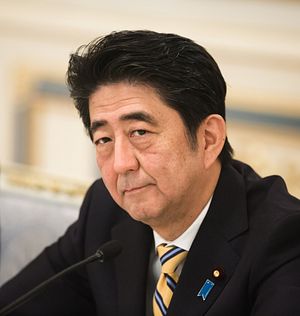The Japanese economy got some good news on December 7 when revised figures by the Japanese government’s Cabinet Office announced that the economy had grown at an annualized rate of 1 percent, rather than contracting by 0.8 percent as the Cabinet Office had previously announced.
Encouragingly, growth was boosted by consumer spending and business investment, two areas that are critical for the possible success of Abenomics, especially as Prime Minister Shinzo Abe has refocused on economics in the lead-up to the 2016 elections for the legislature’s Upper House.
Given Abe’s emphasis on economic growth since returning to office in 2012, the contentious debate over security legislation over the summer, and Abe’s past experience with defeat in the 2007 Upper House elections when voters punished the LDP for prioritizing constitutional reform over economic issues, Abe is correct to focus on the economy and the recent positive GDP growth (along with the opposition parties’ disarray) gives him and the LDP a strong tailwind going into next summer’s elections.
While it’s a good electoral strategy, Japan’s economic fundamentals are still weak. The demographic decline is the most documented, and is adding a “drag” of 2 percent per year on GDP growth, meaning that the Japanese economy would need to grow by 4 percent just to reach a 2 percent growth level that it would need to without a demographic collapse.
And demographics are only one anchor of many pulling Japan down. Japanese firms are sitting on profits rather than investing or raising wages, inflation is dragged down by falling oil prices (removing food and energy costs from inflation calculations would lead inflation to grow by 0.9 percent rather than 0.1 percent as reported in September, closer to the Bank of Japan’s target of 2 percent inflation), the slowdown in China and emerging markets is dampening export growth, the World Bank expects high income countries to grow by only 2.4 percent in 2016, there may be uncertain effects from the U.S. Federal Reserve’s rate increase, while a coming tax hike in 2017, along with Japanese consumers’ traditional frugality, will dampen growth in consumer spending.
Most troubling for Japanese policymakers is the fact that of the anchors listed above, they only have direct control over the consumer tax increase, and even in that case there is pressure to act given Japan’s high deficit and the necessity of increasing revenues to support the aging population. There is a limit to how much the government can lean on firms to invest profits (and many firms complain that the government is already overbearing) while the slowdown in China and other emerging economies, along with low growth projections worldwide, put a very low ceiling on what can be expected. This leaves Japanese policymakers with very little room for error and very little capacity for action.
This is the context in which Prime Minister Abe announced the ichiokusokatsuyaku, or an “Urgent Proposal for Realizing the Dynamic Engagement of All Citizens.” While none of the proposals contained in the document are objectionable, its goals (600 trillion yen economy by 2020, 1.8 births per family, and more) are either impractical (GDP would need to grow by 22 percent each year for the next five years to reach the target) or unsupported by concrete measures to achieve them.
It’s also unclear where the ichiokusokatsuyaku fits in the context of Abenomics, is it a stand-in for the “third arrow” (structural reform), or an entirely new iteration of the original three-arrow strategy? Or does it simply exists unto itself, independent of Abenomics and any of its arrows. An optimistic interpretation could be that the government is trying to “keep its powder dry” before the 2016 elections and plans to undertake more politically challenging reforms afterwards, but most observers in business and the legislature privately concede that the ichiokusokatsuyaku, if it is even more than a slogan, is about as far as the current government will go with structural reform.
This would be unfortunate. Structural reform was the arrow that most observers were awaiting most anxiously and the one which appeared to offer the greatest promise for lasting economic reform. In this regard, Japanese policymakers have no lack of places to try—beyond the oft-cited labor market reforms, immigration reforms, and womenomics, productivity growth needs specific attention since its economy is operating below potential. Productivity growth has been stuck below 2 percent in almost every sector for the past 20 years while doubling its current productivity rate could add 3 percent to annual GDP growth.
Admittedly, the private sector would need to take the lead in achieving these gains through adopting global best practices, improving value chain integration, incorporating higher-technology processes, and more, but the government can support these developments through continued economic integration, particularly in digital commerce, increasing economic partnerships with high-growth emerging economies, and, as mentioned above, labor market reform.
Japan needs more than ichiokusokatsuyaku to achieve this, especially since it needs to grow more aggressively than a comparable economy to meet its goals. Optimists can continue to hope the administration will tackle reform after the election, because the current strategy isn’t enough to justify optimism, never mind growth.

































